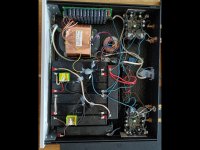That goes against the theme of many a British old wives' tale ...Yes, I know some knobs go to 11, but that only makes matters worse.
Just went through a Danish used market online, and this amplifier for sale put a dum grin on my face, a battery powered diy amp using Holton modules, just look at all that hot glue and wiring, measly 650 us dollars, it's a nightmare.
Attachments
Step 1. Find an online "bignum calculator" which can do integer arithmetic using integers with hundreds of digits. I happen to prefer (this one) but there are dozens to choose from; Google finds them easily. If you have Linux, try the "bc" program.
Step 2. ask it to multiply 123123123123123123 times 37. That's just a whole lot of repetitions of "123" , times thirty seven.
Step 3. Marvel at the result.
Step 4. Repeat with 456456456456456 times 37
Step 5. Repeat with 789789789789789 times 37
Step 6. Explain.
Step 2. ask it to multiply 123123123123123123 times 37. That's just a whole lot of repetitions of "123" , times thirty seven.
Step 3. Marvel at the result.
Step 4. Repeat with 456456456456456 times 37
Step 5. Repeat with 789789789789789 times 37
Step 6. Explain.
To save time I asked the well known AI Deep Thought.
Seems the answer to all three is 42
The explanation is easy...
Seems the answer to all three is 42
The explanation is easy...
There are about 38 knobs, and if we assume each knob has 10 positions, then there are 10 * 38th power of possible setting combinations.
Your chance of guessing correctly is, well, slim to none, as you may have already experienced.
Yes, I know some knobs go to 11, but that only makes matters worse.
Does it have a USB or ethernet interface inside? Maybe it needs a Raspberry inside.
This reminds me of something I utterly don't understand but like a lot. (No, not my wife, but could be her too)10 * 38th power of possible setting combinations.
Your chance of guessing correctly is, well, slim to none, as you may have already experienced.
Well, and yes, it's not really a joke, but might lighten moods.
Attachments
So, the morphology of a sober Tony playing a CD player with a Bose system ( if he had one ) is obvious and is a trivial machine. Ie: the probability that music will come out of the speakers is 100%. Whether you like that or not is left as an exercise for another thesis.
But, the morphology of a Tony after a few drinks trying to play an LP is fuzzy and non deterministic, hence it becomes a non trivial machine... ie: a crap shoot with a high probability that sound will not come out of the speakers and a hungover Tony will be spending lots of money on a new cartridge the next day.
However, add the machinations of the typical DIY audiophile: boxes, knobs, switches, cables, lights ( always BLUE of course ) and the morphology becomes complicated but obvious: as simple as the complexity of the system will allow. It also becomes non-trivial as it may require some tweaking to adjust the bias of some component in order to satisfy the required output of the process: ie music that satisfies the soul.
Add some tubes along the way, or a Korg that went microphonic because it doesn't like Hoff's music, and you got a non trivial system for sure.
Now, I posit that the morphology of current High End systems is incorrect: the expenses and over the top visual design spent on the casework are not required for the end result: to make music. Only to satisfy the "carriage trade". Indeed, a call to Italy for the "deluxe case" at 5U and 400mm depth is the most correct for the audio application: it looks like a box, it is a box, it has the holes were you want them and if in aluminum it is applies the weight where is most applicable: the doughnut inside. The existence of the MacIntosh MC901 is proof of my assertion.
I ought to write such a thesis and become a Doctor of Philosophy... just use a few polysillabic (oof, itself polysyllabic... recursive eh?) BIG SHOT words... quotes from Chomsky and Putin and I'm set.

Credit: www.irwincorey.org
But, the morphology of a Tony after a few drinks trying to play an LP is fuzzy and non deterministic, hence it becomes a non trivial machine... ie: a crap shoot with a high probability that sound will not come out of the speakers and a hungover Tony will be spending lots of money on a new cartridge the next day.
However, add the machinations of the typical DIY audiophile: boxes, knobs, switches, cables, lights ( always BLUE of course ) and the morphology becomes complicated but obvious: as simple as the complexity of the system will allow. It also becomes non-trivial as it may require some tweaking to adjust the bias of some component in order to satisfy the required output of the process: ie music that satisfies the soul.
Add some tubes along the way, or a Korg that went microphonic because it doesn't like Hoff's music, and you got a non trivial system for sure.
Now, I posit that the morphology of current High End systems is incorrect: the expenses and over the top visual design spent on the casework are not required for the end result: to make music. Only to satisfy the "carriage trade". Indeed, a call to Italy for the "deluxe case" at 5U and 400mm depth is the most correct for the audio application: it looks like a box, it is a box, it has the holes were you want them and if in aluminum it is applies the weight where is most applicable: the doughnut inside. The existence of the MacIntosh MC901 is proof of my assertion.
I ought to write such a thesis and become a Doctor of Philosophy... just use a few polysillabic (oof, itself polysyllabic... recursive eh?) BIG SHOT words... quotes from Chomsky and Putin and I'm set.
Credit: www.irwincorey.org
Last edited:
Silly, you know the answer... the cat dies -or not.
Let M(x) be Murphy and S(c) be Schrodinger
Where the possible values of M(x) are { 0, 1 } and for S(c) are { dead, alive }
So.
M(x) x S (c) = 0 x dead = alive
M(x) x S (c) = 0 x alive = dead
M(x) x S (c) = 1 x dead = dead
M(x) x S (c) = 1 x alive = alive
QED
More importantly: why are Nelson Pass designs always spec'd with a BLUE LED?
Let M(x) be Murphy and S(c) be Schrodinger
Where the possible values of M(x) are { 0, 1 } and for S(c) are { dead, alive }
So.
M(x) x S (c) = 0 x dead = alive
M(x) x S (c) = 0 x alive = dead
M(x) x S (c) = 1 x dead = dead
M(x) x S (c) = 1 x alive = alive
QED
More importantly: why are Nelson Pass designs always spec'd with a BLUE LED?
A blue LED is like a potato chip.
You can't have just one.
You can't have just one.
Because it's the color of the best music on the planet, IMHO.More importantly: why are Nelson Pass designs always spec'd with a BLUE LED?
I was gonna take a picture of the amp racks to show you how many BLUE LEDS could face me.... however, if I turned on all the amps at the same time it would surely trip the breaker.
Sometimes I have to wear shades not to get blinded by them BLUE LEDs... yikes.
My preamp has a red light.
I like red.... sounds like Chopin having fun in a Maison of ill repute.
Perhaps I ought to replace all them BLUE LEDs with a 12V trigger outlet at the rear that is hooked up to a voltage triggered 120VAC strip that turns on some Lava Lamps.... that would make Nelson Pass sound groovy. The question then.. will blue lava lamps sound better than red lava lamps?
Come to think about it.. the A2 runs hot enough... all I got to do is put the lava lamp glass vessel on top of the amp. Turn it on and when the lava is blubbing then I know the amp is warmed and ready to go.
Sometimes I have to wear shades not to get blinded by them BLUE LEDs... yikes.
My preamp has a red light.
I like red.... sounds like Chopin having fun in a Maison of ill repute.
Perhaps I ought to replace all them BLUE LEDs with a 12V trigger outlet at the rear that is hooked up to a voltage triggered 120VAC strip that turns on some Lava Lamps.... that would make Nelson Pass sound groovy. The question then.. will blue lava lamps sound better than red lava lamps?
Come to think about it.. the A2 runs hot enough... all I got to do is put the lava lamp glass vessel on top of the amp. Turn it on and when the lava is blubbing then I know the amp is warmed and ready to go.
Last edited:
My Outlaw Audio 7075 power amps have LEDs in the power switches that are red when the units are powered down, then turn blue when you switch them on. I find this particular color combo/sequence rather off-putting for some reason. (Not enough to do anything about it of course - just enough to whine about it a little.)
- Home
- Member Areas
- The Lounge
- Something to lighten the mood


 IIRC)
IIRC)